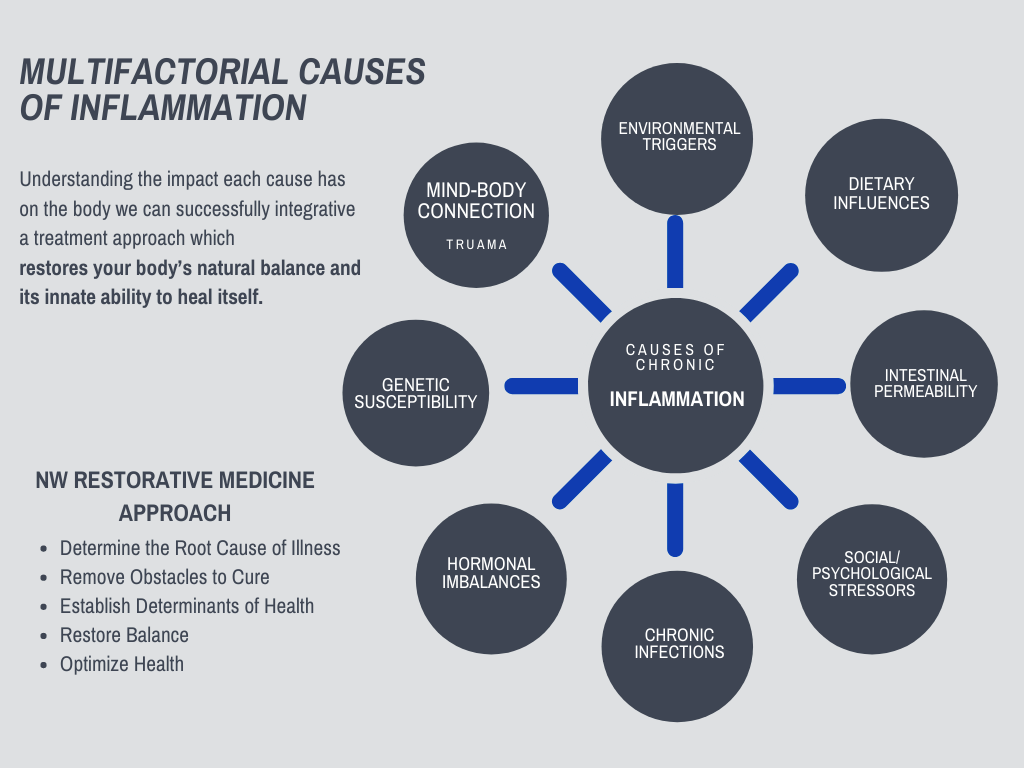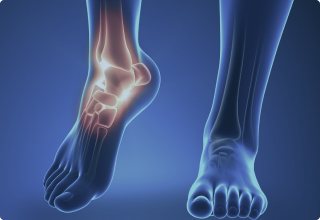Natural Ankle and Foot Pain Relief
The ankle and foot have multiple ligaments and tendons working together to stabilize the joints. Foot and ankle pain is often the result of an injury, such as a sprain or strain, but also can be from wear and tear resulting in tendinopathy or arthritis.
Your Ankle and Foot are Connected to Your Whole Body, and so is Your Pain and Inflammation
As a result, the cause of ankle and foot pain and inflammation comes from many factors, requiring a whole-body approach to relieving pain.
Dr. Squires’ approach brings together a holistic treatment of all the factors contributing to your chronic inflammation and pain. Personalizing treatment to the factors most impacting your source of pain.
And combines it with a Regenerative Medicine approach that stimulates your own body’s healing response naturally.
Regenerative medicine is a cell-based therapy using advanced scientific techniques in the treatment of degenerative disease, orthopedic injuries, and joint conditions.
Discover how Dr. Squires can help by scheduling an initial consult »

If you have experienced a sprained ankle you most likely have experienced multiple sprained ankles or you may have had chronic pain and tightness since a severe sprain.
Injuries to ligaments and tendons in the ankle have a hard time fully healing resulting in laxity of the ligaments and tendons.
Laxity makes them more vulnerable to another injury or leads to tight muscles trying to stabilize the joint because the ligaments and tendons are not doing their job. Instability also sends pain signals to try and get the body to stabilize the joint.
In Summary, chronic strains and sprains of the ankle result in:
- Vulnerability to repeat injuries
- Feelings of instability
- Tight muscles
- Increased Pain
- Progression to degenerative changes
Tendons and ligaments are the soft connective tissues that stabilize the joints. Sudden, intense twisting movements can cause tears. Chronic partial tears can also develop from an insufficiently healed injury or a small tear that progressively worsens over time. Pain and limited mobility that occurs with such a condition can make it difficult or even impossible to get around on a daily basis.
Regenerative Medicine for ligament and tendon injuries
- Prolotherapy uses a dextrose based solution to create an inflammatory response recruiting fibroblast, growth factors, and even stem cells to an area of injury. In turn, this helps stimulate repair of tissues reinforcing connective tissue resulting in ligament/tendon strengthening and stability.
- Platelet Rich Plasma (PRP) seems to enhance angiogenesis (improved blood supply) which may accelerate the healing process.
- Platelet Rich Plasma (PRP) treatment can enhance tendon and ligament healing because it promotes activation, differentiation, and mobilization of stem cells to the area of injury.
- Studies have demonstrated that PRP can increase both the number of cells and the cellular component by enhancing fibroblast proliferation and collagen production, and thus strengthen healed tendons and ligament. These showed that PRP improved not only collagen production in tendons but also their tensile strength and decreased scar tissue formation.
- Extracorporeal Shockwave Therapy (ESWT) has been shown in studies to treat tendonitis or partial thickness tears in the rotator cuff tendons before proceeding to arthroscopic intervention.
- A large number of studies have demonstrated the beneficial effects of PRP on the healing of tendons and ligaments at the molecular, cellular, animal, and human trail levels.
Micro-trauma to the Achilles tendon, caused by repetitive activities such as jumping rope, running long distances, or playing tennis, leads to progressive tendon degeneration. Micro-tearing or partial tearing creates pain, decreased range of motion and can even limit simple activities such as walking.
Conservative treatments include rest, stretching exercises, non-steroidal anti-inflammatories NSAIDs, and physical therapy. Surgery may be indicated depending on the severity of the tears. Something that should be taken into consideration regarding treatments is that there is increasing evidence that NSAID usage may interfere with the healing process and be detrimental in tendinopathy. Many papers show corticosteroids lead to soft tissue damage, cell death, tendon atrophy, and inhibit collagen synthesis.
Regenerative Medicine and Achilles Tendon Injuries
- Platelet Rich Plasma (PRP) seems to enhance angiogenesis (improved blood supply) which may accelerate the healing process.
- Platelet Rich Plasma (PRP) treatment can enhance tendon healing because it promotes activation and differentiation of tendon stem cells.
- Studies have demonstrated that PRP can increase both the number of cells and the cellular component by enhancing fibroblast proliferation and collagen production, and thus strengthen healed tendons and ligament. These showed that PRP improved not only collagen production in tendons but also their tensile strength and decreased scar tissue formation.
- Extracorporeal Shockwave Therapy (ESWT) has been shown in studies to treat tendonitis or partial thickness tears in the Achilles tendon before proceeding to arthroscopic intervention.
- A large number of studies have demonstrated the beneficial effects of PRP on the healing of tendons at the molecular, cellular, animal, and human trail levels.
Plantar fasciitis is a painful, debilitating condition that results from chronic inflammation of the connective tissue underneath the foot. The most common symptoms are pain in the inside of the heal and foot, pain is increased when pointing the toes upwards and weight-bearing on the heel of the foot. This condition is due to repetitive microtrauma or prolonged standing and activity.
Plantar fasciitis is often contributed to laxity of ligaments in the foot occurring after multiple ankle sprains and activates that require repetitive pushing-off motions. Laxity of the ligaments results in the arch of the foot falling lengthening the connective tissue of the fascia increasing stress on the bottom of the foot. A thorough exam is needed to determine the root cause of the condition.
Conservative treatments include rest, stretching exercises, non-steroidal anti-inflammatories NSAIDs, and physical therapy. Surgery may be indicated depending on severity. Something that should be taken into consideration regarding treatments is that there is increasing evidence that NSAID usage may interfere with the healing process. Many papers show corticosteroids lead to: soft tissue damage, cell death, tendon atrophy, and inhibit collagen synthesis.
Regenerative Medicine Therapies for Plantar Fasciitis
- Plantar Fasciitis is a result of chronic low-grade inflammation from repetitive stress and microtrauma. Platelet-rich plasma injections are very efficacious for chronic injury as they initiate and stimulate an appropriate inflammatory cascade, which enhances the healing process.
- Platelet Rich Plasma therapy (PRP) involves using your own blood plasma and platelets as an enriched source of growth factors and immune cells to stimulate healing of bone and soft tissue.
- PRP has been shown to modulate the repair and regeneration of damaged connective tissue.
- Extracorporeal shock wave therapy contributes to healing and pain reduction in plantar fasciitis
Research Studies and References
Positive Effect of Platelet-Rich Plasma on Pain in Plantar Fasciitis: A Double-Blind Multicenter Randomized Controlled Trial
- Peerbooms JC, Lodder P, den Oudsten BL, Doorgeest K, Schuller HM, Gosens T. Positive Effect of Platelet-Rich Plasma on Pain in Plantar Fasciitis: A Double-Blind Multicenter Randomized Controlled Trial. Am J Sports Med. 2019 Nov;47(13):3238-3246. doi: 10.1177/0363546519877181. Epub 2019 Oct 11. PMID: 31603721.
- Conclusion: Treatment of patients with chronic plantar fasciitis with PRP seems to reduce pain and increase function more as compared with the effect of corticosteroid injection.
Platelet rich plasma versus corticosteroid injection for plantar fasciitis: A comparative study
- Jain K, Murphy PN, Clough TM. Platelet rich plasma versus corticosteroid injection for plantar fasciitis: A comparative study. Foot (Edinb). 2015 Dec;25(4):235-7. doi: 10.1016/j.foot.2015.08.006. Epub 2015 Aug 22. PMID: 26362235.
- Conclusions: PRP is as effective as Steroid injection at achieving symptom relief at 3 and 6 months after injection, for the treatment of plantar fasciitis, but unlike Steroid, its effect does not wear off with time. At 12 months, PRP is significantly more effective than Steroid, making it better and more durable than cortisone injection.
- Singh P, Madanipour S, Bhamra JS, Gill I. A systematic review and meta-analysis of platelet-rich plasma versus corticosteroid injections for plantar fasciopathy. Int Orthop. 2017 Jun;41(6):1169-1181. doi: 10.1007/s00264-017-3470-x. Epub 2017 Apr 10. PMID: 28396927.
A systematic review and meta-analysis of platelet-rich plasma versus corticosteroid injections for plantar fasciopathy
- Conclusions: PRP injections are associated with improved pain and function scores at three month follow-up when compared with corticosteroid injections. Information regarding relative adverse event rates and cost implications is lacking. Further, large-scale, high-quality, randomised controlled trials with blinding of outcome assessment and longer follow-up are required.
Plantar neuromas are inflammation of the nerve between your metatarsals (bones in your feet). This is common due to compressive forces on the foot entrapping the nerves between bones and ligaments. Symptoms include pain at the bottom of the foot with possible burning sensation and tingling of toes. Increased pain with walking and wearing shoes.
Plantar neuromas can be treated with perineural injection therapy. Perineural injection therapy decreases nerve inflammation. Prolotherapy of the surrounding ligaments may be necessary if there is laxity in these structures.

I injured my shoulder and was unable to really use it for about 6 months before going to see Dr. Carley Squires. She recommended Platelet-Rich Plasma (PRP) injections to stimulate healing in my shoulder. Dr. Squires took the time to talk to me about the procedure, my concerns, and the expected outcome. I have had great success with the PRP injection and would highly recommend Dr. Squires.
